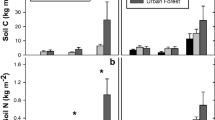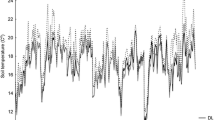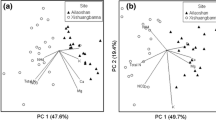Abstract
Healthy soil ecosystems are important for urban sustainability, because they provide the basis for ecosystem services such as flood regulation, nutrient cycling and carbon sequestration. We investigated the soils beneath five types of urban land cover in the tropical city of Singapore—secondary forest, managed grass, shrubs, trees, and trees with shrubs. We quantified the capacity of these soils to support two key ecosystem functions: litter decomposition, which we measured using a standardised tea bag method, and infiltration, which we measured using a double ring infiltrometer. Soil samples (0–20 cm depth) were collected from 120 sites and were analysed for 15 soil and vegetation properties including pH, soil organic matter content, particle size, bulk density and soil nitrogen, phosphorus and potassium. The forest sites had significantly higher leaf litter cover and canopy leaf area index than the other land cover types. Rates of litter decomposition and infiltration were highest in secondary forest, followed by trees with shrubs, and lowest in grass. Litter decomposition rates were positively related to soils with presence of soil invertebrate activity, leaf litter cover and soil nitrogen content. Infiltration rates were negatively related to soil bulk density. To optimise the delivery of soil ecosystem services in tropical cities, city managers and planners should protect any remaining fragments of forest, allow natural succession to occur, plant multi-layered vegetation with trees and shrubs, and restore urban soil by improving soil nutrients, reducing bulk density, and leaving leaf litter in situ.



Similar content being viewed by others
Data availability
The data will be made available from the authors on request..
References
Adhikari K, Hartemink AE (2016) Linking soils to ecosystem services - a global review. Geoderma 262:101–111. https://doi.org/10.1016/j.geoderma.2015.08.009
Anne B, Geoffroy S, Cherel J, Warot G, Marie S, Noël CJ, Louis MJ, Christophe S (2018) Towards an operational methodology to optimize ecosystem services provided by urban soils. Landsc Urban Plan 176:1–9. https://doi.org/10.1016/j.landurbplan.2018.03.019
Archer NAL, Quinton JN, Hess TM (2002) Below-ground relationships of soil texture, roots and hydraulic conductivity in two-phase mosaic vegetation in south-East Spain. J Arid Environ 52:535–553. https://doi.org/10.1006/jare.2002.1011
Berland A, Shiflett SA, Shuster WD, Garmestani AS, Goddard HC, Herrmann DL, Hopton ME (2017) The role of trees in urban stormwater management. Landsc Urban Plan 162:167–177. https://doi.org/10.1016/j.landurbplan.2017.02.017
Bolund P, Hunhammar S (1999) Ecosystem services in urban areas. Ecol Econ 29:293–301. https://doi.org/10.1016/S0921-8009(99)00013-0
Bossio DA, Cook-Patton SC, Ellis PW, Fargione J, Sanderman J, Smith P, Wood S, Zomer RJ, von Unger M, Emmer IM, Griscom BW (2020) The role of soil carbon in natural climate solutions. Nat Sustain 3:391–398. https://doi.org/10.1038/s41893-020-0491-z
Brown S, Miltner E, Cogger C (2012) Carbon sequestration potential in urban soils. In: Carbon sequestration in urban ecosystems. Springer Netherlands, Dordrecht, pp 173–196
Byrne LB (2007) Habitat structure: a fundamental concept and framework for urban soil ecology. Urban Ecosyst 10:255–274. https://doi.org/10.1007/s11252-007-0027-6
Byrne LB (2021) Socioecological soil restoration in urban cultural landscapes. In: Soils and Landscape Restoration. Academic Press, pp. 373-410
Byrne LB, Bruns MA, Kim KC (2008) Ecosystem properties of urban land covers at the aboveground-belowground interface. Ecosystems 11:1065–1077. https://doi.org/10.1007/s10021-008-9179-3
Chong KY, Teo S, Kurukulasuriya B, Chung YF, Rajathurai S, Tan HTW (2014) Not all green is as good: different effects of the natural and cultivated components of urban vegetation on bird and butterfly diversity. Biol Conserv 171:299–309. https://doi.org/10.1016/j.biocon.2014.01.037
Chua SC, Ramage BS, Potts MD (2016) Soil degradation and feedback processes affect long-term recovery of tropical secondary forests. J Veg Sci 27:800–811. https://doi.org/10.1111/jvs.12406
Corlett RT (1991) Plant succession on degraded land in Singapore. J Trop For Sci 4:151–161
Corlett RT (1992) The ecological transformation of Singapore, 1819-1990. J Biogeogr 19:411. https://doi.org/10.2307/2845569
Couteaux MM, Bottner P, Berg B (1995) Litter decomposition, climate and liter quality. Trends Ecol Evol 10:63–66. https://doi.org/10.1016/S0169-5347(00)88978-8
De Kimpe CR, Morel JL (2000) Urban soil management: a growing concern. Soil Sci 165:31–40. https://doi.org/10.1097/00010694-200001000-00005
Dean WEJ (1974) Determination of carbonate and organic matter in calcareous sediments and sedimentary rocks by loss on ignition: comparison with other methods. SEPM J Sediment Res 44:242–248. https://doi.org/10.1306/74d729d2-2b21-11d7-8648000102c1865d
Dominati EJ (2013) Natural capital and ecosystem services of soils. Ecosyst Serv New Zeal Cond trends:132–142
Duddigan S, Alexander PD, Shaw LJ, Sandén T, Collins CD (2020) The tea bag index-UK: using citizen/community science to investigate organic matter decomposition rates in domestic gardens. Sustain 12. https://doi.org/10.3390/SU12176895
Edmondson JL, Stott I, Davies ZG, Gaston KJ, Leake JR (2016) Soil surface temperatures reveal moderation of the urban heat island effect by trees and shrubs. Nat Publ Gr 6. https://doi.org/10.1038/srep33708
Eijkelkamp (2015) Double ring Infiltrometer manual. Double Ring Infiltrom:1–9
Facelli JM, Pickett STA (1991) Plant litter: its dynamics and effects on plant community structure. Bot Rev 57:1–32. https://doi.org/10.1007/BF02858763
Ferreira CSS, Walsh RPD, Ferreira AJD (2018) Degradation in urban areas. Curr Opin Environ Sci Heal 5:19–25. https://doi.org/10.1016/j.coesh.2018.04.001
Fujii K, Shibata M, Kitajima K, Ichie T, Kitayama K, Turner BL (2018) Plant–soil interactions maintain biodiversity and functions of tropical forest ecosystems. Ecol Res 33:149–160. https://doi.org/10.1007/s11284-017-1511-y
Gaw LY-F, Yee ATK, Richards DR (2019) A high-resolution map of Singapore’s terrestrial ecosystems. Data 4:116. https://doi.org/10.3390/data4030116
Ghosh S, Deb S, Ow LF, Deb D, Yusof ML (2019) Soil characteristics in an exhumed cemetery land in Central Singapore. Environ Monit Assess 191:191. https://doi.org/10.1007/s10661-019-7291-9
Ghosh S, Fern Ow L, Wilson B (2015) Influence of biochar and compost on soil properties and tree growth in a tropical urban environment. Int J Environ Sci Technol 12 (4):1303-1310
Ghosh S, Scharenbroch BC, Burcham D, Ow LF, Shenbagavalli S, Mahimairaja S (2016) Influence of soil properties on street tree attributes in Singapore. Urban Ecosyst 19:949–967. https://doi.org/10.1007/s11252-016-0530-8
Golubiewski NE (2006) Urbanization increases grassland carbon pools: effects of landscaping in Colorado’s front range
Greinert A (2015) The heterogeneity of urban soils in the light of their properties. J Soils Sediments 15:1725–1737. https://doi.org/10.1007/s11368-014-1054-6
Grubb PJ, Turner IM, Burslem DFRP (1994) Mineral nutrient status of coastal hill dipterocarp forest and adinandra belukar in Singapore: analysis of soil, leaves and litter. J Trop Ecol 10:559–577. https://doi.org/10.1017/S0266467400008233
Hansen RA (2000) Effects of habitat complexity and composition on a diverse litter microarthropod assemblage. Ecology 81:1120–1132. https://doi.org/10.1890/0012-9658(2000)081[1120:EOHCAC]2.0.CO;2
Haygarth PM, Ritz K (2009) The future of soils and land use in the UK: soil systems for the provision of land-based ecosystem services. Land Use Policy 26:187–197. https://doi.org/10.1016/j.landusepol.2009.09.016
Heneghan L, Miller SP, Baer S, Callaham MA Jr, Montgomery J, Pavao-Zuckerman M, Rhoades CC, Richardson S (2008) Integrating soil ecological knowledge into restoration management. Restor Ecol 16:608–617. https://doi.org/10.1111/j.1526-100X.2008.00477.x
Housing & Development Board (2020) Yishun. Retrieved from https://www.hdb.gov.sg/cs/infoweb/about-us/history/hdb-towns-your-home/yishun on 24 October 2020
Hwang YH, Feng Y, Tan PY (2016) Managing deforestation in a tropical compact city (part B): urban ecological approaches to landscape design. Smart Sustain Built Environ 5:73–92. https://doi.org/10.1108/SASBE-08-2015-0023
7 Indian Air Survey Company, and 110 Map Production Company RE (1945) Singapore and Johore Bahru. Retrieved from https://libmaps.nus.edu.sg on 15 October 15 2020
IPBES (2018) The IPBES assessment report on land degradation and restoration. Bonn, Germany
Jenny H (1994) Factors of soil formation: a system of quantitative Pedology. Dover Publications, New York
Jim CY (1998) Urban soil characteristics and limitations for landscape planting in Hong Kong. Landsc Urban Plan 40:235–249. https://doi.org/10.1016/S0169-2046(97)00117-5
Jouquet P, Traoré S, Choosai C, Hartmann C, Bignell D (2011) Influence of termites on ecosystem functioning. Ecosystem services provided by termites. Eur J Soil Biol 47:215–222. https://doi.org/10.1016/j.ejsobi.2011.05.005
Keesstra SD, Bouma J, Wallinga J, Tittonell P, Smith P, Cerdà A, Montanarella L, Quinton JN, Pachepsky Y, van der Putten WH, Bardgett RD, Moolenaar S, Mol G, Jansen B, Fresco LO (2016) The significance of soils and soil science towards realization of the United Nations sustainable development goals. Soil 2:111–128. https://doi.org/10.5194/soil-2-111-2016
Keuskamp JA, Dingemans BJJ, Lehtinen T, Sarneel JM, Hefting MM (2013) Tea bag index: a novel approach to collect uniform decomposition data across ecosystems. Methods Ecol Evol 4:1070–1075. https://doi.org/10.1111/2041-210X.12097
Kjeldahl C (1883) A new method for the determination of nitrogen in organic matter. Z Anal Chem 22:366–382
Krishna MP, Mohan M (2017) Litter decomposition in forest ecosystems: a review. Energy. Ecol Environ 2:236–249
Layman RM, Day SD, Mitchell DK, Chen Y, Harris JR, Daniels WL (2016) Below ground matters: urban soil rehabilitation increases tree canopy and speeds establishment. Urban For Urban Green 16:25–35. https://doi.org/10.1016/j.ufug.2016.01.004
Le Maitre DC, Scott DF, Colvin C (1999) A review of information on interactions between vegetation and groundwater. Water SA 25:137–152
Lee S, Phau I, Quintal V (2017) Journal of heritage tourism exploring the effects of a “new” listing of a UNESCO world heritage site: the case of Singapore botanic gardens. 13:339–355. https://doi.org/10.1080/1743873X.2017.1354005
Liu YF, Liu Y, Wu GL, Shi ZH (2019) Runoff maintenance and sediment reduction of different grasslands based on simulated rainfall experiments. J Hydrol 572:329–335. https://doi.org/10.1016/j.jhydrol.2019.03.008
Mapa RB (1995) Effect of reforestation using Tectona grandis on infiltration and soil water retention. For Ecol Manag 77:119–125. https://doi.org/10.1016/0378-1127(95)03573-S
McGrane SJ (2016) Impacts of urbanisation on hydrological and water quality dynamics, and urban water management: a review. Hydrol Sci J 61:2295–2311. https://doi.org/10.1080/02626667.2015.1128084
Mehlich A (1984) Mehlich 3 soil test extractant: a modification of Mehlich 2 extractant. Commun Soil Sci Plant Anal 15:1409–1416. https://doi.org/10.1080/00103628409367568
Meyer S, Rusterholz HP, Salamon JA, Baur B (2020) Leaf litter decomposition and litter fauna in urban forests: effect of the degree of urbanisation and forest size. Pedobiologia (Jena) 78:150609. https://doi.org/10.1016/j.pedobi.2019.150609
Millennium Ecosystem Assessment (2005) Ecosystems and human well-being. Island Press, Washington, D.C., USA
National Environment Agency. (2019). Climate of Singapore. Retrieved from http://www.weather.gov.sg/climate-climate-of-singapore/ on 18 June 2019
National Parks Board. (2018). Guidelines on greenery provision and tree conservation for developments version 2. Greenery & Development Planning Branch. Singapore: National Parks Board
Moore JAM, Sulman BN, Mayes MA, Patterson CM, Classen AT (2019) Plant roots stimulate the decomposition of complex, but not simple, soil carbon. Funct Ecol 34:899–910. https://doi.org/10.1111/1365-2435.13510
Nilsson MC, Wardle DA (2005) Understory vegetation as a forest ecosystem driver. Ecol Soc Am 3:421–428. https://doi.org/10.1890/1540-9295(2005)003[0421:UVAAFE]2.0.CO;2
Ossola A, Hahs AK, Livesley SJ (2015) Habitat complexity influences fine scale hydrological processes and the incidence of stormwater runoff in managed urban ecosystems. https://doi.org/10.1016/j.jenvman.2015.05.002
Ossola A, Hahs AK, Nash MA, Livesley SJ (2016) Habitat complexity enhances comminution and decomposition processes in urban ecosystems. Ecosystems 19:927–941. https://doi.org/10.1007/s10021-016-9976-z
Ossola A, Livesley SJ (2016) Drivers of soil heterogeneity in the urban landscape. In: Francis R, Millington J, Chadwick M (eds) Urban landscape ecology: science, policy and practice. pp 19–41
Pavao-Zuckerman MA (2008) The nature of urban soils and their role in ecological restoration in cities. Restor Ecol 16:642–649. https://doi.org/10.1111/j.1526-100X.2008.00486.x
Phillips TH, Baker ME, Lautar K, Yesilonis I, Pavao-Zuckerman MA (2019) The capacity of urban forest patches to infiltrate stormwater is influenced by soil physical properties and soil moisture. J Environ Manag 246:11–18. https://doi.org/10.1016/j.jenvman.2019.05.127
Pierret A, Moran CJ (2011) Plant roots and soil structure. In: Encyclopedia of Earth Sciences Series. Springer Netherlands, pp. 628–632
Pitts J (1984) A review of geology and engineering geology in Singapore. Q J Eng Geol Hydrogeol 17:93–101. https://doi.org/10.1144/gsl.qjeg.1984.017.02.02
Pouyat RV, Yesilonis ID, Russell-Anelli J, Neerchal NK (2007) Soil chemical and physical properties that differentiate urban land-use and cover types. Soil Sci Soc Am J 71:1010–1019. https://doi.org/10.2136/sssaj2006.0164
Ren X, Hong N, Li L, Kang J, Li J (2020) Effect of infiltration rate changes in urban soils on stormwater runoff process. Geoderma 363:114158. https://doi.org/10.1016/j.geoderma.2019.114158
Richards DR, Tunçer B (2018) Using image recognition to automate assessment of cultural ecosystem services from social media photographs. Ecosyst Serv 31:318–325. https://doi.org/10.1016/j.ecoser.2017.09.004
Richards DR, Fung TK, Belcher RN, Edwards PJ (2020) Differential air temperature cooling performance of urban vegetation types in the tropics. Urban For Urban Green 50:126651. https://doi.org/10.1016/j.ufug.2020.126651
Robertson GP, Paul EA (2000) Decomposition and soil organic matter dynamics. Methods in Ecosystem Science. Springer New York, In, pp 104–116
Scalenghe R, Ajmone-Marsan F (2009) The anthropogenic sealing of soils in urban areas. Landsc Urban Plan 90:1–10. https://doi.org/10.1016/j.landurbplan.2008.10.011
Scharenbroch BC, Lloyd JE, Johnson-Maynard JL (2005) Distinguishing urban soils with physical, chemical, and biological properties. Pedobiologia (Jena) 49:283–296. https://doi.org/10.1016/j.pedobi.2004.12.002
Setälä H, Marshall VG, Trofymow JA (1996) Influence of body size of soil fauna on litter decomposition and 15N uptake by poplar in a pot trial. Soil Biol Biochem 28:1661–1675. https://doi.org/10.1016/S0038-0717(96)00252-0
Sim JWS, Tan HTW, Turner IM (1992) Adinandra belukar : an anthropogenic in Singapore. Vegetatio 102:125–137
Smith P, Adams J, Beerling DJ et al (2019) Land-management options for greenhouse gas removal and their impacts on ecosystem services and the sustainable development goals. Annu Rev Environ Resour 7:40. https://doi.org/10.1146/annurev-environ-101718
Smith P, House JI, Bustamante M et al (2016) Global change pressures on soils from land use and management. Glob Chang Biol 22:1008–1028. https://doi.org/10.1111/gcb.13068
Tan PY, Liao K, Hwang YH, Chua V (2018) Nature, Place & People
Teixeira da Silva R, Fleskens L, van Delden H, van der Ploeg M (2018) Incorporating soil ecosystem services into urban planning: status, challenges and opportunities. Landsc Ecol 33:1087–1102. https://doi.org/10.1007/s10980-018-0652-x
Teo A, Kristensen NP, Keuskamp JA, Evans TA, Foo M, Chisholm RA (2020) Validation and extension of the tea bag index to collect decomposition data from termite-rich ecosystems. Pedobiologia (Jena) 80:150639. https://doi.org/10.1016/j.pedobi.2020.150639
Teo XYA (2017) Influence of biodiversity on ecosystem function in primary and secondary forests of Singapore: microclimate, litterfall, and decomposition. National University of Singapore
Tresch S, Frey D, Le Bayon RC et al (2019) Litter decomposition driven by soil fauna, plant diversity and soil management in urban gardens. Sci Total Environ 658:1614–1629. https://doi.org/10.1016/j.scitotenv.2018.12.235
Vauramo S, Setälä H (2010) Urban belowground food-web responses to plant community manipulation – impacts on nutrient dynamics. Landsc Urban Plan 97:1–10. https://doi.org/10.1016/j.landurbplan.2010.04.004
Velasco E, Roth M, Norford L, Molina LT (2016) Does urban vegetation enhance carbon sequestration? Landsc Urban Plan 148:99–107. https://doi.org/10.1016/j.landurbplan.2015.12.003
Yang JL, Zhang GL (2015) Formation, characteristics and eco-environmental implications of urban soils – a review. Soil Sci Plant Nutr 61:30–46. https://doi.org/10.1080/00380768.2015.1035622
Yang JL, Zhang GL (2011) Water infiltration in urban soils and its effects on the quantity and quality of runoff. J Soils Sediments 11:751–761. https://doi.org/10.1007/s11368-011-0356-1
Yee ATK, Chong KY, Neo L, Tan HTW (2016) Updating the classification system for the secondary forests of Singapore. Raffles Bull Zool 2016:11–21
Yee ATK, Corlett RT, Liew SC, Tan HTW (2011) The vegetation of Singapore ― an updated map. Gard Bull Singapore 63:205–212
Acknowledgements
The research was conducted at the Future Cities Laboratory at the Singapore-ETH Centre, which was established collaboratively between ETH Zurich and Singapore’s National Research Foundation (FI 370074016) under its Campus for Research Excellence and Technological Enterprise programme. The authors would like to thank the National Parks Board, Town Councils, Public Utilities Board, and National University of Singapore for permission to conduct the field surveys (Permit number NP/RP16-096); Song Xiao Ping, Emmanuel Goh, Chan Jie Yi, Hazelina Yeo, Leon Gaw, Mohamed Lokman Mohd Yusof, Norazan Asari B Shamsudin, Syakirah Shukor, Jonathon Tan, Song Shuang and Chiam Zhongyu for field assistance; Darren Yeo and Tommy Tan for equipment loan; Boo Chih Min for plant species identification; and three anonymous reviewers for their insightful comments and suggestions. All authors declare no conflict of interest.
Code availability
Not applicable.
Funding
The research was conducted at the Future Cities Laboratory at the Singapore-ETH Centre, which was established collaboratively between ETH Zurich and Singapore’s National Research Foundation (FI 370074016) under its Campus for Research Excellence and Technological Enterprise programme. The funders had no role in study design, data collection and analysis, decision to publish, or preparation of the manuscript.
Author information
Authors and Affiliations
Contributions
Conceptualisation: TKF, DRR, and PJE; Methodology: TKF, DRR, and SG; Investigation: TKF, CTWJ, LKL, DRR, RATL, and ZD; Formal analyses: TKF and DRR; Data curation: TKF and DRR, Project administration: TKF; Visualisation: TKF and DRR, Writing – Original draft: TKF; Writing –Review & editing: TKF, DRR, PJE, RATL, SG, CTWJ, ZD; Supervision: PJE; Funding acquisition: PJE. All authors gave final approval for publication.
Corresponding author
Ethics declarations
Ethics approval
Not applicable.
Consent to participate
Not applicable.
Consent for publication
Not applicable.
Conflicts of interest/competing interests
The authors declared that they have no conflict of interest.
Supplementary Information
ESM 1
(DOCX 138 kb)
Rights and permissions
About this article
Cite this article
Fung, T., Richards, D.R., Leong, R.A. et al. Litter decomposition and infiltration capacities in soils of different tropical urban land covers. Urban Ecosyst 25, 21–34 (2022). https://doi.org/10.1007/s11252-021-01126-2
Accepted:
Published:
Issue Date:
DOI: https://doi.org/10.1007/s11252-021-01126-2




